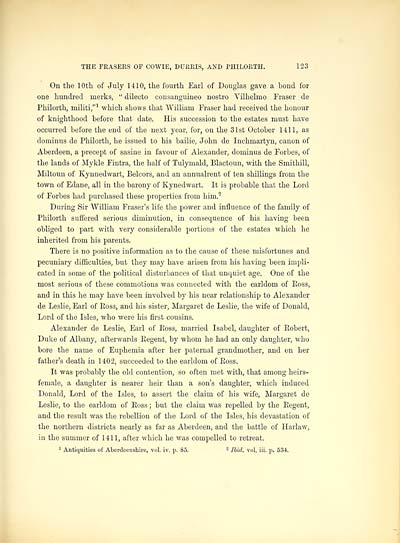Frasers of Philorth > Volume 1
(157)
Download files
Complete book:
Individual page:
Thumbnail gallery: Grid view | List view

THE FKASERS OF COWIE, DURRIS, AND PHILORTH. 123
On the 10th of July 1410, the fourth Earl of Douglas gave a bond for
one hundred merks, " dilecto consanguineo nostro Vilhelmo Fraser de
Philorth, militi," 1 which shows that William Fraser had received the honour
of knighthood before that date. His succession to the estates must have
occurred before the end of the next year, for, on the 31st October 1411, as
dominus de Philorth, he issued to his bailie, John de Inchmartyn, canon of
Aberdeen, a precept of sasine in favour of Alexander, dominus de Forbes, of
the lands of Mykle Fintra, the half of Tulymald, Blactoun, with the Smithill,
Miltoun of Kynnedwart, Belcors, and an annualrent of ten shillings from the
town of Edane, all in the barony of Kynedwart. It is probable that the Lord
of Forbes had purchased these properties from him. 2
During Sir William Fraser's life the power and influence of the family of
Philorth suffered serious diminution, in consequence of his having been
obliged to part with very considerable portions of the estates which he
inherited from his parents.
There is no positive information as to the cause of these misfortunes and
pecuniary difficulties, but they may have arisen from his having been impli-
cated in some of the political disturbances of that unquiet age. One of the
most serious of these commotions was connected with the earldom of Eoss,
and in this he may have been involved by his near relationship to Alexander
de Leslie, Earl of Eoss, and his sister, Margaret de Leslie, the wife of Donald,
Lord of the Isles, who were his first cousins.
Alexander de Leslie, Earl of Eoss, married Isabel, daughter of Eobert,
Duke of Albany, afterwards Eegent, by whom he had an only daughter, who
bore the name of Euphemia after her paternal grandmother, and on her
father's death in 1402, succeeded to the earldom of Eoss.
It was probably the old contention, so often met with, that among heirs-
female, a daughter is nearer heir than a son's daughter, which induced
Donald, Lord of the Isles, to assert the claim of his wife, Margaret de
Leslie, to the earldom of Eoss ; but the claim was repelled by the Eegent,
and the result was the rebellion of the Lord of the Isles, his devastation of
the northern districts nearly as far as Aberdeen, and the battle of Harlaw,
in the summer of 1411, after which he was compelled to retreat.
1 Antiquities of Aberdeenshire, vol. iv. p. 85. 2 Ibid. vol. iii. p. 534.
On the 10th of July 1410, the fourth Earl of Douglas gave a bond for
one hundred merks, " dilecto consanguineo nostro Vilhelmo Fraser de
Philorth, militi," 1 which shows that William Fraser had received the honour
of knighthood before that date. His succession to the estates must have
occurred before the end of the next year, for, on the 31st October 1411, as
dominus de Philorth, he issued to his bailie, John de Inchmartyn, canon of
Aberdeen, a precept of sasine in favour of Alexander, dominus de Forbes, of
the lands of Mykle Fintra, the half of Tulymald, Blactoun, with the Smithill,
Miltoun of Kynnedwart, Belcors, and an annualrent of ten shillings from the
town of Edane, all in the barony of Kynedwart. It is probable that the Lord
of Forbes had purchased these properties from him. 2
During Sir William Fraser's life the power and influence of the family of
Philorth suffered serious diminution, in consequence of his having been
obliged to part with very considerable portions of the estates which he
inherited from his parents.
There is no positive information as to the cause of these misfortunes and
pecuniary difficulties, but they may have arisen from his having been impli-
cated in some of the political disturbances of that unquiet age. One of the
most serious of these commotions was connected with the earldom of Eoss,
and in this he may have been involved by his near relationship to Alexander
de Leslie, Earl of Eoss, and his sister, Margaret de Leslie, the wife of Donald,
Lord of the Isles, who were his first cousins.
Alexander de Leslie, Earl of Eoss, married Isabel, daughter of Eobert,
Duke of Albany, afterwards Eegent, by whom he had an only daughter, who
bore the name of Euphemia after her paternal grandmother, and on her
father's death in 1402, succeeded to the earldom of Eoss.
It was probably the old contention, so often met with, that among heirs-
female, a daughter is nearer heir than a son's daughter, which induced
Donald, Lord of the Isles, to assert the claim of his wife, Margaret de
Leslie, to the earldom of Eoss ; but the claim was repelled by the Eegent,
and the result was the rebellion of the Lord of the Isles, his devastation of
the northern districts nearly as far as Aberdeen, and the battle of Harlaw,
in the summer of 1411, after which he was compelled to retreat.
1 Antiquities of Aberdeenshire, vol. iv. p. 85. 2 Ibid. vol. iii. p. 534.
Set display mode to:
![]() Universal Viewer |
Universal Viewer | ![]() Mirador |
Large image | Transcription
Mirador |
Large image | Transcription
Images and transcriptions on this page, including medium image downloads, may be used under the Creative Commons Attribution 4.0 International Licence unless otherwise stated. ![]()
| Histories of Scottish families > Frasers of Philorth > Volume 1 > (157) |
|---|
| Permanent URL | https://digital.nls.uk/96567384 |
|---|
| Attribution and copyright: |
|
|---|
| Description | A selection of almost 400 printed items relating to the history of Scottish families, mostly dating from the 19th and early 20th centuries. Includes memoirs, genealogies and clan histories, with a few produced by emigrant families. The earliest family history goes back to AD 916. |
|---|

